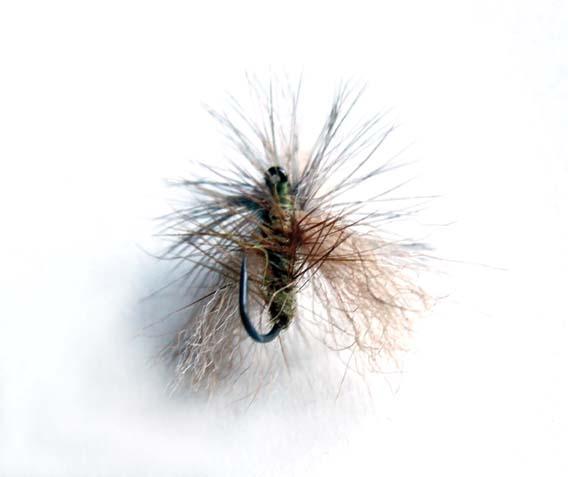Spruce Moth Down
The spruce bud worm is no friend to the forests, but after a decade or so of this "late-summer-early-fall" phenomenon, trout everywhere are conditioned to the late-season treat. The spruce moth is the adult stage of this persistent pest, which causes a lot of wilting and defoliation in Western forests. Due to the cool, damp spring these buggers were a little slow in showing, but from now until the first hard freeze, they'll be a fly fisher's favorite.
Spruce moths are blown from the forest into streams and have the swimming skills of dead wood. That's why a successful pattern is pretty much a corpse with active legs—Cutthroat will swim backward all the way to town watching a drowning moth to make sure it's fish food. And that gets us to the Spruce Moth Down.
Patterns for this terrestrial are often variations of the old standby, the elk-hair caddis. Most of the pattern is polypropylene, the best floater of synthetic materials, and the Spruce Moth Down stays right in the surface film but floats indefinitely. If the fly rides too high, though, it's subject to wind and currents that make it appear unnatural. The palmered body has just enough flash to attract, and the hackle gives the fly support and action enough to be believable. Try it. I think you'll like it... the trout sure do.
Materials
Hook: Tiemco 102Y, size 13,15
Thread: UniThread, Olive Dun, 8/0
Dubbing: Wapsi Super Bright, Ginger
Wings/Post: Wapsi Polypro, Oyster White & Medium Brown Blend
Hackle: Whiting Silver Rooster Hackle, Brown
Instructions
1. Debarb the hook and then overlay the thread to the hook bend.
2. Tie in the hackle for palmered legs. Dub carrot shape back to the tie-in spot. Trim out the top of the hackle to make room for the wings.
3. Tie in blended polypro, extending the wing one-third of the way beyond the bend of the hook. Secure wind wraps with under & over wraps.
4. Divide and figure 8 the wings to separate. Make one loop to pull together. (Casting will force the wings to divide.)
5. Re-enforce the front of the wings, then dub under the post to force it upright. Wrap the post to prepare for the hackle. Wrap top down.
6. Use a little masking-tape saddle to separate the wings from the parachute hackle. Tie in the hackle to wrap in clockwise.
8. Tie off hackle under the front dubbing, whip finish, groom parachute for the best spread, trim the post, and trim the wings. Add a dot of cement for a head and the wing junction. Now go fish!
In addition to being a grumpy old fart, Gary Jones teaches fly tying at several local schools, builds and repairs graphite rods, drives school buses for Gateway School, works periodically at Greater Yellowstone Flyfishers at Four Corners, writes and draws, and likes to entertain friends. Oh, and he fishes a lot. Other than that, he really doesn't have much of a life.












